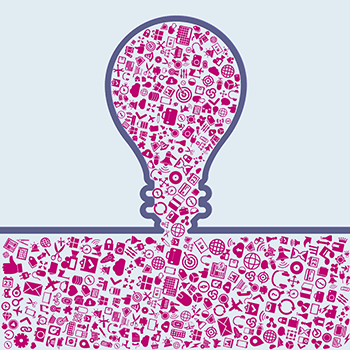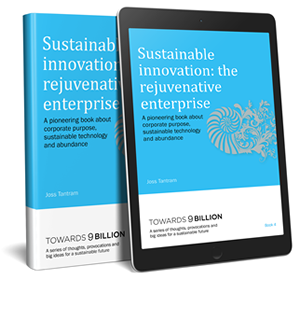Introduction
Rejuvenative (definition): “To restore to a former state; make fresh or new again.”
Our Towards 9 Billion blog is almost 4 years old.  Over that time we have produced, at least once a month, commentary, analysis or big ideas on topics ranging from energy, physics, economics, natural philosophy and the promise and perversity of the human condition. With our Towards 9 Billion E-book series coming out this year, which collects together our thinking and analysis, this blog provides a short overview of one of the key themes of Towards 9 Billion – the need and hope for innovation towards a sustainable, equitable future.
Over that time we have produced, at least once a month, commentary, analysis or big ideas on topics ranging from energy, physics, economics, natural philosophy and the promise and perversity of the human condition. With our Towards 9 Billion E-book series coming out this year, which collects together our thinking and analysis, this blog provides a short overview of one of the key themes of Towards 9 Billion – the need and hope for innovation towards a sustainable, equitable future.
Rejuvenative innovation…beyond stasis
“We are called to be architects of the future, not its victims.
R. Buckminster Fuller
Different outcomes require different means. This truism is at the heart of the sustainability challenge. Can we solve the problems of tomorrow with the tools of today?
What new approaches, mechanisms and technologies are required and will evolve in responses to the challenges of resource scarcity, consumption pressure, biodiversity loss and the emerging cracks in our current economic and market systems?
At its heart sustainability is about innovation: of our ways of understanding and responding to the world; of organising ourselves; in the invention, development and deployment of new technologies and also, perhaps most crucially; in our systems of production and distribution. Whilst the future may well see a flowering of wondrous sustainable technologies, it will also need to feature new ways of conceiving of the point and purpose of enterprise and economics, we call this “Rejuvenative innovation”.
At the levels of manufacture and production this innovation is rejuvenative technology and rejuvenative enterprise; technologies and initiatives whose impacts innately add to the quality and quantity of life on this planet.
Many of the seeds of a sustainable future already exist and whilst new things will undoubtedly be required, many of the techniques, concepts and technologies we need are potentially available for use, if we can prioritise, develop and value their contribution to a successful future on a physically constrained, populous planet.
The idea of Rejuvenative Enterprise and technology draws upon and builds from a number of sources, – it is majorly influenced by Amory Lovin’s (et al) Natural Capitalism, The Natural Step, Cradle-to-Cradle and biomimicry/ bio-facture concepts, combined with our own thoughts and experiences over the last 20 years.
In addition, beyond what already exists, we also point towards new and as yet undiscovered approaches to natural manufacturing that are currently more sci fi than sci-reality.
Abundant thinking
“Probable impossibilities are to be preferred to improbable possibilities.”
Aristotle
Rejuvenation of our technology must be accompanied by a rejuvenation in our approach to economics and value. A key element of this is the idea of valuing abundance rather than focusing our conceptions of value upon scarcity.
Where price is based upon scarcity, it will always be more valuable to pursue ever scarcer supplies of a given resource, because the price of that resource will be driven higher and higher by the conventional laws of supply and demand.
Basing price on abundance (i.e. the likelihood of a resource being capable of providing utility to the greatest possible number of the world’s population) seems to be a more valuable and sustainable approach for capitalism then eternally pursuing ever decreasing traces of non-renewable resources.
Such abundance can be either natural (e.g. biologically based) or managed (e.g. through closed loop stewardship).
Terra sapiens – evolving to a truly planetary species
“Human nature is hung in the balance; our behaviour driven by selfishness & our desire to cooperate to ensure survival”
E.O. Wilson
Sustainability also poses a fundamental challenge to the genetic and social capabilities of our species, requiring a perspective shift from the interests of our family and friends, to those of our communities, nations, regions and ultimately all members of our species. The development of truly global thinking will challenge the way we conceive of those we care about and how we do so, requiring the conceptualisation of true global citizenship.
At the heart of this challenge concerning human capability and capacity is the question of the limits and capability of our species’ sapience. It is not intelligence per se which is important, but ‘sapience’ – having or showing great wisdom or sound judgment.
Our species certainly has much to prove to demonstrate that we have the wisdom or judgment required to achieve a sustainable world.
Moving from Homo sapiens to Terra sapiens must be rooted in a clear eyed understanding of what we are as a species, our capacities, weaknesses, shortcomings and strengths. Recognising the biology and psychologies which drive us is a vital aspect of driving the sapience we need for a sustainable future on a populous planet.
New challenges, new opportunities
“The future belongs to those who believe in the beauty of their dreams.”
Eleanor Roosevelt
This blog explores these and other challenges by posing questions about our intelligence and capacity for sustainability and defining and suggesting new ways of conceiving and categorising those fundamental elements of sustainable technology and value that we believe will be essential tools for building a sustainable world.
We suggest and explore the idea of social utility as a fundamental metric for social purpose, arguing that an examination of how companies give rise to social quality and capacity will be those most valuable and sustainable over the long term.
We explore how abundance might be placed at the heart of price, how the technologies that will deliver a sustainable world might be categorised in terms that investors can recognise and explore the limitations and opportunities our species faces in responding to the power and responsibility we have in creating planetary level change.
The rejuvenative revolution is about hope. Hope for our future and hope for the evolution of our systems of production and value, whilst recognising the limits of both our knowledge and our capacity to act with wisdom and judgement in the face of global challenges.
Out now – Towards 9 Billion book series
We have packaged a range of our writing over the last few years into a series of short, paperbacks/ E-books, which are available now.
There are 5 in the series and are available from Amazon. You can download free excerpts from each book by going to www.terrafiniti.com/towards-9-billion-books

Here are just some of the kind things people have said about our work:
“Building a sustainable future will take evolution and revolution, mixing what already works and challenging what does not. Terrafiniti’s Towards 9 Billion creates positive, playful ideas which help us describe and drive a future where we and our planet can flourish together.”
KoAnn Vikoren Skrzyniarz; Founder, Chief Executive, Sustainable Brands
“Terrafiniti’s Towards 9 Billion initiative raises powerful questions, and some equally powerful answers. Their sharp thinking combines a rational approach to analyse in a subtle way the wicked problems of our complex and rapidly changing world, for the common good of present and future generations.”
Alain Ruche, Senior adviser to the SG of the EU External Service (EEAS)
“Terrafiniti’s Towards 9 Billion is a creative approach for putting people and the planet at the heart of value. By pushing the boundaries of our thinking it poses serious questions and argues that the seeds of the future may already lie within our current, unsustainable approaches.”
Jeremy Nicholls, Chief Executive, Social Value UK
Sowing the seeds of a sustainable world?
Just as plants and animals broadcast seed and progeny in vast numbers in the hope that some will survive and flourish, we hope that our ideas might have the chance to do the same; to find receptive places in which to thrive.
We hope that our writing and the books might play a small but useful role in imagining and building a future fit for people and the planet.


Leave a Reply